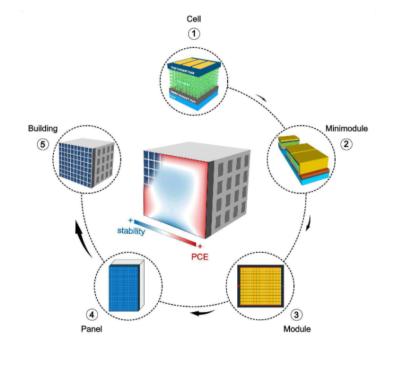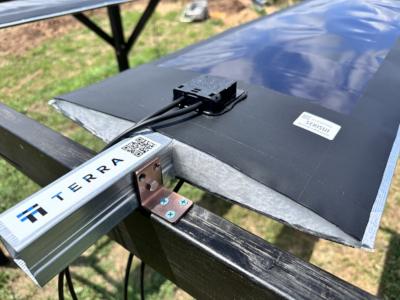Perovskite Solar - Page 9
INES and 3SUN announce 29.8% efficiency record for a 9 cm² perovskite-on-silicon tandem cell
The close collaboration between researchers at France's National Solar Energy Institute (INES) – a division of the French Alternative Energies and Atomic Energy Commission (CEA) - and 3SUN has reportedly yielded a certified efficiency record for a perovskite-on-silicon tandem photovoltaic cell measuring 9 cm² after shading correction.
The team explained that most of the efficiency records published internationally relate to a surface area of 1 cm². They said that the surface is a real challenge that they are addressing in their developments. This result marks a new stage in the development of PIN-type 2-terminal tandem cells. The progress is evident, with 26.5% in March 2023, then 27.1% in June 2023, 28.4% in December 2023, 28.7% last June and now 29.8%, for devices showing a Voc greater than 1900 mV.
A new edition of the Perovskite for the Solar Industry Market Report
We have released a new edition of the Perovskites for the Solar Industry market report. This report, over 140 pages long, is a comprehensive guide to next-generation perovskite-based solutions for the solar industry that enable efficient, low cost, lightweight and unique solar solutions. The new edition includes 11 new companies and the latest research and project activity.
The perovskite industry is moving fast towards commercialization and our report is a must-read for anyone that wishes to become an expert on this emerging industry and market.
Reading this report, you'll learn all about:
- The perovskite solar industry and market
- The advantages and challenges of perovskite PVs
- Perovskite PV developers and supply chain companies
- What the future holds for the perovskite market and industry
The report also provides:
- Market segmentation by technology, geography, applications and more
- The latest efficiency records (by PV type)
- Details on perovskite collaborative research projects
- A market snapshot and forecast
- Free updates for a year
Reliance Industries plans to commercialize perovskite PV within the next two years
Reliance Industries, which owns 20% of perovskite solar developer Caelux, has updated that in addition to developing first-generation bifacial solar panels using indigenized HJT technology, it is also working on perovskites and back-contact HJT-IBC, which it expects to commercialize within the next two years.
Mukesh D Ambani, chairman and managing director of Reliance Industries recently said that Reliance will commence the production of its solar photovoltaic (PV) modules by the end of this year. In the following quarters, the group will complete the first phase of its integrated solar production facilities including modules, cells, glass, wafer, ingot, and polysilicon, with an initial annual capacity of 10 GW. The giga-factory is designed for modular expansion and can be expanded to 20 GW at minimal cost and shortest time possible.
Molecule-triggered strain regulation strategy for efficient inverted perovskite solar cells
Researchers from the Chinese Academy of Sciences, Beijing Institute of Technology and Shanghai Lettee Perovskite Optoelectronic Technology have addressed the issue of residual tensile strain - which impedes the improvement of efficiency and intrinsic stability of perovskite solar cells (PSCs) (resulting from the perovskite lattice distortion and different thermal expansion coefficients). To this end, they proposed a molecule-triggered strain regulation and interfacial passivation strategy to enhance the efficiency and stability (especially photostability) of PSCs.
Their strategy utilizes the [2 + 2] cycloaddition reaction of 6-bromocoumarin-3-carboxylic acid ethyl ester (BAEE), consuming the incident UV light to suppress the tensile strain evolution.
Novel surface reconstruction strategy sets out to reduce Sn defects in all-perovskite tandem solar cells
Researchers from China's Huazhong University of Science and Technology, Wuhan University of Technology and Huaneng Clean Energy Research Institute have reported a surface reconstruction strategy utilizing a surface polishing agent, 1,4-butanediamine, together with a surface passivator, ethylenediammonium diiodide, to eliminate Sn-related defects and passivate organic cation and halide vacancy defects on the surface of Sn–Pb mixed perovskite films.
The team explained that while all-perovskite tandem solar cells have shown great promise in breaking the Shockley–Queisser limit of single-junction solar cell, their efficiency is often hindered by the surface defects induced non-radiative recombination loss in Sn–Pb mixed narrow bandgap perovskite films. The strategy detailed in their recent work not only delivers high-quality Sn–Pb mixed perovskite films with a close-to-ideal stoichiometric ratio surface, but also minimizes the non-radiative energy loss at the perovskite/electron transport layer interface.
Researchers report an effective method to enhance electron transport in wide bandgap and perovskite-silicon tandem solar cells
An international team of researchers, including ones from the University of Sydney, IEK-5 Photovoltaics at Forschungszentrum Jülich, Southern University of Science and Technology, UNSW and the University of Ljubljana, recently reported the use of a piperidinium bromide (PpBr) as an interlayer between C60 and perovskite. The interlayer was further optimized by introducing an additional oxygen atom on the opposite side of the NH2+.
The tandem structure that the team used for demonstrations. Image credit: Advanced Energy Materials
This reportedly resulted in morpholinium bromide (MLBr) with increased dipole moment. Because of this, MLBr was highly effective in minimizing the energy band mismatch between perovskite and C60 layer for electron extraction while at the same time passivating defects.
Flexell Space and Airbus team up to develop perovskite/CIGS tandem PV for space applications
Flexell Space, an in-house venture of Hanwha Systems, has announced that it has signed a letter of intent (LOI) with Airbus Defence and Space GmbH (Airbus) to develop next-generation space solar cell modules using perovskite/CIGS tandem solar cell technology. This collaboration aims to revolutionize the efficiency and weight of space solar cells, marking a significant milestone in the aerospace industry.
Through this agreement, Flexell Space and Airbus plan to design and develop space solar cell modules that are more than half the weight of existing models while maintaining performance and efficiency. By applying Flexell Space's tandem solar cell technology, the new solar cells will aim to offer low cost, high efficiency, rapid production, and flexibility.
Novel self-passivation technique combats efficiency deterioration in perovskite solar cells
As the area of perovskite films and devices increases, their performance tends to deteriorate - which researchers from the Chinese Academy of Science (CAS), University of Science and Technology of China and Dalian University of Technology explain can be linked to defects that accumulate at the bottom surface without proper passivation. In an attempt to address this issue, the team introduced a unique molecule (1-(4-Fluorophenyl)−2-pyrrolidone, or FPP) as an additive in large-area blade-coating perovskite films.
During the top-down crystallization process, the FPP molecule forms an intermediate phase with the perovskite components and subsequently self-deposits at the bottom surface. Consequently, the crystallization kinetics of the large-area thin films are regulated, and the bottom surface is effectively and uniformly passivated in one single-step processing.
Novel multiscale computational framework to assist in the design and characterization of building-integrated perovskite photovoltaics
Eindhoven University of Technology researchers have developed a multiscale computational framework for scaling up perovskite photovoltaics from cell scale to building integration.
The novel framework includes three key modeling components: (i) cell scale, incorporating a coupled optical-electrical-thermal model to characterize performance and hysteresis of small-area perovskite solar cells, (ii) module scale, designing monolithically interconnected perovskite minimodules and quantifying upscaling losses, and (iii) building scale, assessing complex interactions between environmental factors and building-integrated perovskite photovoltaics.
Sekisui Chemical and TERRA commence joint demonstration test of agrivoltaic perovskite solar cells in Japan
Sekisui Chemical and TERRA recently announced that they have commenced the first joint demonstration test in Japan to install film-type perovskite solar cells for agrivoltaics (solar sharing) at Sosa City, Chiba Prefecture on August 2, 2024.
Sekisui Chemical has created a 30 cm-wide roll-to-roll manufacturing process utilizing its original “sealing, film formation, materials and process technology,” and has reportedly confirmed 10 years equivalent of outdoor durability, which is critical to the development of film-type perovskite solar cells. Furthermore, this manufacturing process has been successfully used to produce film-type perovskite solar cells with a power generation efficiency of 15.0%. Development is being accelerated to further improve durability and power generation efficiency, as well as to establish manufacturing technology for 1 m-wide rolls.
Pagination
- Previous page
- Page 9
- Next page










